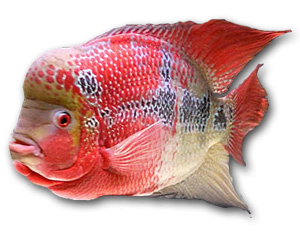Flowerhorn

Quick Stats
| Size | Up to 12" (30cm) |
|---|---|
| Tank | 180 litres + |
| Swimming Area | Bottom, middle |
| Ph | 7.0 to 7.8 |
| Temperature | 80ºF to 89ºF (27 - 32°C) |
| Food | Pellet, live and frozen foods |
Common Name:
Flowerhorn, Hua Luo Han
Distribution:
None, not a naturally occurring species. Parent stock from South America. Thought to be the end product of cross breeding between the Cichlasoma Trimaculatus, Cichlasoma Festae, Jingang Blood Parrot etc.
Colouration:
Coloration can vary from the native locale and the age of the fish. All are stunning, bright and can command a high price.
Lifespan:
8 to 10 years.
Maintenance:
10 to 20% weekly. They are very aggressive in nature. Coexisting with other fish is not advisable, especially smaller fish. This fish has quite a nasty bite depending on the size of the fish.
Feeding:
Krill, Blood Worms, and Cichlid pellets every day. It is a fast growing fish.
Substrate:
Sand.
Tank Decor:
The tank should be decorated in typical Cichlid fashion, providing open swimming areas as well as caves and driftwood for hiding. Plastic plants are best as they will dig.
Filtration:
Good filtration as it can be a messy fish, especially when fed live food.
Biotype:
Not a naturally occurring species so no biotype available
Breeding:
Sexing the flower horn can be attempted the following way: The most accurate way is look at the anal pore of the fish. The male fish has a V-shaped anal pore. As for the female, it will have a U - shaped anal pore. Generally, it will be easier to identify the sex of the fish when it is around 4 inches in length. Breeding should be typical of any of the large parent stock like Cichlasoma Trimaculatus or Cichlasoma Festae. As many as 1000 eggs are usually laid on a flat surface like a piece of slate or sometimes on rocks on the tank bottom. The eggs are guarded by the female and the male will keep all others away. The eggs will hatch in about 3 days and then the fry will be moved to large pits in the substrate where the parents will continue their care. After about 5 days the fry are free swimming and can be fed the small food needed for growth.